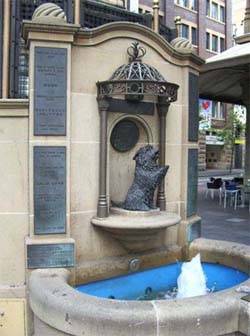History of Cairns in NSW

By Robert Bartram, 2007.
The Cairn Wishing well located outside of the Queen Victoria Building in central Sydney, NSW and was made around 1974 with Jason Roberts as the sculptor. His inspiration for this sculpture was a painting by Sir Edwin Landseer's depicting Queen Victoria's prick-eared Skye (as Cairns were known at the time), "Islay" c.1839. He visited NSW Cairn Club members and photographed their dogs very thoroughly, then made a small cold cast followed by an exact copy in the larger version, all hand finished. There were 16 replicas (8" x 10") made which belong to some members of the Cairn Club at that time, and those who donated funds for the project have their names on the plaque at the side. It is situated not far from a large statue of Queen Victoria herself and the proceeds from the wishing well go to a worthwhile charity.
Cairn Terriers in NSW
It is difficult to say with any certainty when
It says a great deal about the charm and character of the breed that in less than two decades after the breed's recognition by the Kennel Club in 1912 it already had a foothold in this country and had clearly worked it's way in to the affection of those half a world away from the country of origin. The 30s and 40s saw a number of people enter the breed, many of them with dogs acquired from Victoria and South Australia..
The principal source from Victoria was Miss Elsa Grice (RAHWEEN) an early stalwart of the breed in that State, and the importer of a number of
Mr J Bowden provided a number of people in NSW with ALLENBY stock from his kennel in South Australia. It was in the late 40s that Mr Bowden sent Allenby Chief and Allenby Peggy to Mr and Mrs C Groom as foundation stock for their LUTON Cairns, who were already well known in Fox Terrier circles. In 1947 Mr and Mrs Perdriau bought a bitch Pixie of DURNSFORD from Mr J K T Watson in Tasmania and started their STROMNESS kennels. It was also in the late 40s that Dr E Coles got her first Cairn PICTON Silver from Mrs Campbell. It was not until some years later that she got a bitch from Mr and Mrs Perdriau and registered her VIWA prefix.
The breed's popularity increased considerably in the 1950s with a number of well known and influential kennels forming. Foremost among these was the CRATHIEs of Mr and Mrs A H Murray founded on CH CAIRNTOUL BONNY SCOT bred here in NSW by Mrs Henry from basically Victorian stock. The Murrays
Mr and Mrs Ken Lowe (ROMSEY) from Soth Australia were very well known in Australian Terrier circles as well as Cairns, with their cairn terrier CH ALLENBY Pirate winning a BIS All Breeds, probably the first in the state for the breed. Mr Lowe was a well known and highly respected judge who was given the honour of judging the Terrier Group at a Sydney Royal in the 1960s.
With the acquisition of VIWA Beta from Dr Coles in 1960 Margaret Hill had the foundation bitch for her RAWHITI kennel. She in turn provided foundation stock for Kitch Robinson's LOCHAWE kennel. The three ladies of Homebush...VIWA...RAWHITI....LOCHAWE aided by their good friends Rosemary Boyd (TIRALUINN) and Dorothy Watkins (HOPELEIGH) have bred carefully over many years with much success. Margaret, Kitch and Rosemary are all Life Members of the Club having given sterling service over many years.
The late 1960s and 1970s saw not only an increase in the number of people involved in the breed but an upturn in the number of imports...mostly from UK. For the next two decades the most significant kennel was the LUTONs of Jean Groom. With a number of significant imports, the most well known being CH CRAIGLYN Crofter (twice British Terrier Club Top Terrier and Best in Show at British Terrier shows), the LUTONs enjoyed an unequalled run of success at Royals, All Breeds shows and Breed Shows. . From 1974 to 1990 Jean bred and/or owned BIS at the Club Show on no less than 13 occasions. An impressive record!
My own CRAIGEND kennel was founded in 1964 have enjoyed a fair measure of success over the last few decades. BIS at the Club Show in 1980 and 1985 they have then gone on to win BIS a further 13 times since 1991 the last time being in 2006 with CH CRAIGEND CANDLEBARK winning her 7th Breed Club show.
With the death of Jean Groom and the retirement of a number of other regular exhibitors the numbers shown in NSW in the 1990's and 2000's have been considerably reduced. It is common to find most entries at the average weekend all breeds show in single figures and not unusual to sometimes find none entered at all. However there are encouraging signs!
Mrs Palmer (TOWSYTYKE) started in the 1980s in Queensland but has for some time now been based in Northern NSW. With a combination of existing Australian stock, American and more recently Swedish imports Mrs Palmer is actively breeding and exhibiting and doing much to promote the breed throughout the State.
Ginnette Loft and Peter Miller (EMERALDCITY) started their kennel in the '90's and are well known regular exhibitors enjoying considerable success and encouraging new exhibitors into the breed.
In a brief article such as this it is impossible to mention everyone who made a contribution to both the Club and the breed. Inevitably some people will not appear. Please accept my apologies as it's impossible to include everyone but rest assured that your efforts on behalf of the breed and the Club have truly been appreciated.
